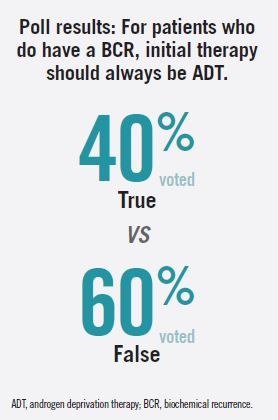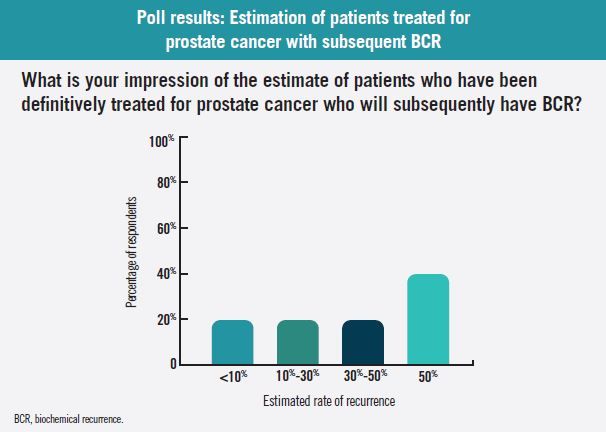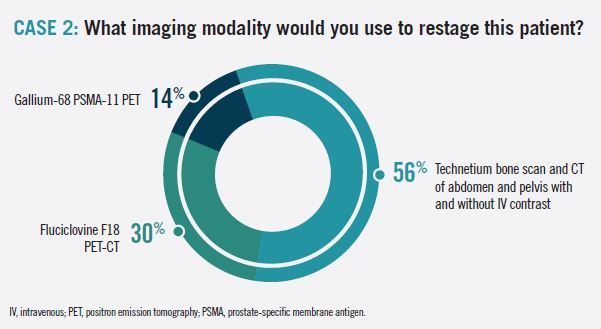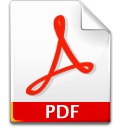The Management of Biochemical Recurrence in Prostate Cancer
This article reviews new imaging technologies that may improve early detection of biochemical recurrence after definitive treatment for prostate cancer. This article also features insights from oncology experts Raoul Concepcion, MD; Judd Moul, MD; Brian Helfand, MD; Munir Ghesani, MD.
KEY TAKEAWAYS
- After radical prostatectomy, a rise in prostate-specific antigen (PSA) level to 0.2 ng/mL or greater is
considered recurrence. For patients with high-risk disease, consecutive rises in PSA level prior to reaching 0.2 ng/mL is also considered a recurrence. - It is important to look at the surgical pathology because in some cases, benign glands at the margin can result in low levels of PSA that are not cancer related. Identifying recurrence is more challenging after definitive radiotherapy because the prostate gland remains in situ, and therefore some level of PSA is detectable.
- Therapy should be initiated for patients with Gleason scores of greater than 8 at the time of surgery, if biochemical recurrence is less than 3 years and if the PSA doubling time is less than 9 to 12 months.
- The recommended imaging modality is a positron emission tomography (PET) CT or PET MRI. The most widely available agent is fluciclovine, a fluorine 18-based agent, used to localize recurrent disease in patients who are presenting with increased PSA levels.
- There are multiple agents and combinations currently under investigation that may become
available over the next few years. 18F-DCFPyL, a second-generation prostate-specific membrane antigen PET agent, is furthest along in the FDA review process and will most likely be considered as the next agent for approval. - Overall, the greatest unmet need for patients with prostate cancer is the ability to localize disease reliably with current imaging modalities at very low PSA levels.
New imaging technologies improve early detection of biochemical recurrence (BCR) after definitive treatment for prostate cancer, but the clinical role of these imaging modalities and management based on these results continue to have unanswered questions, according to experts who participated in a recent CancerNetwork® Around the Practice virtual presentation, moderated by Raoul Concepcion, MD, of the Comprehensive Prostate Center in Nashville, Tennessee. The presentation featured an interactive online platform in which audience members answered several polling questions, which were discussed by the panelists.
Follow-up After Definitive Treatment for Prostate Cancer
The first polling question asked the audience to estimate the percentage of patients definitively treated for prostate cancer who would subsequently have BCR. Of the respondents, 40% estimated a BCR rate of 30% to 50% in this group of patients, whereas 20% estimated rates of less than 10%, 10% to 30%, and more than 50%, respectively. The second polling question asked for a true or false response to the following statement: “For patients who do have a BCR, initial therapy should always be androgen deprivation therapy (ADT).” Of the respondents, 60% answered “false,” and 40% answered “true.”


For patients who received initial definitive therapy, the National Comprehensive Cancer Network (NCCN) guidelines recommend measuring prostate-specific antigen (PSA) every 6 to 12 months for 5 years and then annually thereafter, along with an annual digital rectal examination (which may be omitted if PSA is undetectable).1 Judd Moul, MD, of the Duke Cancer Center in Durham, North Carolina, said that after radical prostatectomy, he typically sees his patients every 3 months for the first year. If their features are particularly high-risk, he will continue to see them every 3 to 4 months for up to 3 years, and if lower risk, he will decrease visits to every 6 months for the next 2 to 3 years and annually thereafter up to 10 years.
Although various PSA cutpoints have been used to define BCR, Brian Helfand, MD, of NorthShore University Health System and University of Chicago in Chicago, Illinois, said that he uses a PSA level of 0.2 ng/mL as the cutoff following radical prostatectomy, as results from one study showed that most (86%) postoperative patients with PSA level greater than 0.2 ng/mL developed PSA progression by year 1, with a 100% (95% CI, 87%-100%) risk of progression by year 3.2 Helfand added that most people would agree that consecutive rises in PSA on an ultrasensitive assay before reaching 0.2 ng/mL are also considered a BCR, especially with higher-risk disease.
Identifying recurrence following radiation therapy is more challenging because the in situ prostate gland produces a low level of PSA, according to Helfand. He uses what he refers to as the Phoenix definition (PSA level 2 ng/mL greater than the lowest PSA level reached), which had a sensitivity and specificity of 64% and 74%, respectively, for predicting clinical failure in one study.3 He added that consecutive rises in PSA level taken at least 1 month apart also increase suspicion for recurrence.
Although the PSA nadir usually occurs within 3 to 6 months following define ADT (androgen deprivation therapy) plus radiation therapy, Moul said that it can take up to 18 months to reach the PSA nadir following radiation therapy without ADT. Moul added that detectable PSA unrelated to cancer may be observed in a subset of patients who have benign glands at the surgical margin after radical prostatectomy.
When deciding whether to initiate treatment with a BCR, the panelists said that the timing of recurrence is important to consider, and Helfand added that a rapid rate of PSA doubling is particularly concerning. Results from a study of 379 men with BCR showed that a pathological Gleason score of 8 or higher, 3 or fewer years from radical prostatectomy to recurrence, and PSA doubling time less than 3 months or 3.0 to 8.9 months were independently associated with shorter time to disease-specific mortality. Concepcion said that a patient with these risk factors would be at risk for succumbing to his disease if therapy were not initiated.4
Case 1: The panelists discussed the case of a White man, age 58 years, who presented in 2010 with a PSA level of 15 ng/mL. Transrectal ultrasonography-guided biopsy showed that 5 of 12 core biopsies were positive and classified as Gleason group 2, and staging work-up was negative. Surgical pathology after robotically assisted radical prostatectomy showed pathologic stage of T3a. The PSA level was 0.8 ng/mL 6 months after surgery, but follow-up was not done for another 3 years when he had a PSA level of 8.3 ng/mL. The patient was asymptomatic and had no signs of metastatic disease on bone scan and CT.
The first polling question regarding case 1 asked the audience whether they would start this patient on ADT. Of the respondents, 66% answered yes, 17% answered no, and 16% said there was not enough information to decide.


Munir Ghesani, MD, of the Icahn School of Medicine at Mount Sinai in New York, New York, pointed out that the current standard of care for work-up has changed since 2013 and includes several imaging options beyond the conventional bone scan and CT (summarized in the NCCN guidelines).1 18F-fluciclovine is a positron emission tomography (PET)–CT radiotracer that, according to Ghesani, is currently available at most commercial radiopharmacies across the United States. The LOCATE trial (NCT02680041) showed that 18F-fluciclovine PET-CT detected lesions in the pelvic region or prostate bed in 52% of patients with negative or equivocal pelvic CT and changed management plans in 59% of all patients.5 According to Ghesani, 11C-choline is also an approved radiotracer for PET, but its short half-life limits its availability to sites that have a cyclotron. In December 2020, the FDA approved Gallium-68 PSMA-11 (68Ga-PSMA-11) for PET for men with suspected metastases of prostate cancer that are potentially curable by surgery or radiation therapy or suspected recurrence of prostate cancer based on PSA levels, although Ghesani noted that the approval is currently limited to University of California, Los Angeles, University of California, San Francisco, and sites performing studies that have approached the FDA about cross-referencing the investigational new drug.6
A poll of the audience revealed that 47% of respondents would use 18F-fluciclovine PET-CT to image and restage the case patient, whereas 30% would use 68Ga-PSMA-11 PET-CT and 23% would use technetium bone scan. However, the panelists noted that many insurance carriers cover only the 18F-fluciclovine PET-CT after a bone scan and CT have been performed, and some even limit coverage to patients with a minimum PSA level of 2.0 ng/mL. Furthermore, Ghesani said that bone scan and CT have low sensitivity for detection of BCR and often fail to show the extent of disease when recurrence is detected, which can lead to suboptimal targeting of treatment. He stressed the importance of collaborating with insurance providers and societies to eliminate the requirements for bone scans and CT prior to more sensitive imaging modalities in the near future.
Case 2: The panelists discussed the case of an African American man, age 64 years, who presented in March 2016 with a PSA level of 5.8 ng/mL. Multiparametric MRI of the prostate revealed a prostate gland volume of 66.3 mL and a Prostate Imaging Reporting and Data System 4 lesion of 1.5 cm to the right peripheral zone. Mechanical fusion biopsy showed that 2 of 3 core biopsies of the right peripheral zone had Gleason group 3 (4 + 3), and 3 of 12 systematic biopsies showed Gleason group 4 (4 + 4) in the mid-left peripheral zone. The patient underwent external beam radiation therapy but declined ADT. Serial PSAs showed a rise from 0.8 ng/mL in June 2017 to 1.7 ng/mL in June 2018.
In the first polling question about the case, the majority (approximately 90%) of the audience members recommended restaging the patient. In the next question, 56% of respondents said that they would use CT and technetium bone scan to restage the patient. Other answer choices receiving responses included18F-fluciclovine PET-CT (30%) and 68Ga-PSMA-11 PET-CT (14%). Moul said that his approach to the case patient would depend in part on the patient’s current health and life expectancy. “If he’s in poor health, I would probably observe him,” he said. “If he was in robust health, or…had a greater than 10-year life expectancy, I would work him up.” Moul added that 18F-fluciclovine PET-CT would be “an ideal imaging test” in the work-up.


Ghesani said that according to at least 1 study, 68Ga-PSMA-11 PET-CT may have better sensitivity for BCR than 18F-fluciclovine PET-CT in the setting of a very low PSA level. Findings from a prospective trial (NCT03515577) showed that the detection rates were significantly higher with 68Ga-PSMA-11 (56%) than with 18F-fluciclovine (26%) in 50 patients with PSA level of 0.2 to 2.0 ng/mL (odds radio, 4.8; P = .0026).7 However, Ghesani said that 18F-fluciclovine PET is still considerably more sensitive than CT and bone scan. “If only fluciclovine PET is available, it still will be very appropriate to do that scan,” he said.
Ghesani added that patients are usually scanned sooner after injection with the 18F-fluciclovine PET-CT than with 68Ga-PSMA-11, and the lower degree of urinary excretion may be advantageous for identifying small areas of recurrence in the prostate bed. Results of a prospective study of patients with BCR after definitive primary therapy (N = 58) showed that detection rates of 18F-fluciclovine versus 68Ga-PSMA-11 varied by location of recurrence: 18F-fluciclovine had a higher rate of detection than that of 68Ga-PSMA-11 for local recurrence (37.9% vs 27.6%; P = .03), a similar rate for local pelvic lymph nodes (46.6% vs 50%; P = .71), and a lower rate for extrapelvic lymph nodes (41.4% vs 51.7%; P = .26) and bone (25.9% vs 36.2%; P = .23).8 The study authors concluded that further research is needed but suggested that the varying strengths of each tracer may complement each other.8
Emerging Imaging Modalities and Future Directions
Ghesani said that at least 5 combinations of 2 gallium-based and 3 fluorine-based radiotracer agents are in the pipeline, with the second-generation PSMA-PET agent 18F-DCFPyL the furthest along in the FDA review process. However, Helfand noted that the ability to reliably localize disease with low PSA level remains the greatest unmet need regarding BCR and detection, and identifying the roles for recently approved and emerging radiotracers will be important moving forward. Moul concluded that although the new imaging modalities are clinically useful, care must be taken to avoid overly aggressive management, particularly in older patients. “Don’t forget to keep your doctor’s hat on and look at the patient, look what’s in front of you, and put it in context,” he said.
REFERENCES
1. NCCN. Clinical Practice Guidelines in Oncology. Prostate cancer, version 2.2021. Accessed April 2, 2021. https://www.nccn.org/professionals/physician_gls/pdf/prostate.pdf
2. Freedland SJ, Sutter ME, Dorey F, Aronson WJ. Defining the ideal cutpoint for determining PSA recurrence after radical prostatectomy. prostate-specific antigen. Urology. 2003;61(2):365-369. doi:10.1016/s0090-4295(02)02268-9
3. Horwitz EM, Thames HD, Kuban DA, et al. Definitions of biochemical failure that best predict clinical failure in patients with prostate cancer treated with external beam radiation alone: a multi-institutional pooled analysis. J Urol. 2005;173(3):797-802. doi:10.1097/01.ju.0000152556.53602.64
4. Freedland SJ, Humphreys EB, Mangold LA, et al. Risk of prostate cancer-specific mortality following biochemical recurrence after radical prostatectomy. JAMA. 2005;294(4):433-439. doi:10.1001/jama.294.4.433
5. Andriole GL, Kostakoglu L, Chau A, et al. The impact of positron emission tomography with 18f-fluciclovine on the treatment of biochemical recurrence of prostate cancer: results from the LOCATE trial. J Urol. 2019;201(2):322-331. doi:10.1016/j.juro.2018.08.050
6. 68Ga-PSMA-11. Prescribing information. University of California; 2020. Accessed April 7, 2021. https://www.accessdata.fda.gov/drugsatfda_docs/label/2020/212642s000lbl.pdf
7. Calais J, Ceci F, Eiber M, et al. 18F-fluciclovine PET-CT and 68Ga-PSMA-11 PET-CT in patients with early biochemical recurrence after prostatectomy: a prospective, single-centre, single-arm, comparative imaging trial. Lancet Oncol. 2019;20(9):1286-1294. doi:10.1016/S1470-2045(19)30415-2
8. Pernthaler B, Kulnik R, Gstettner C, Salamon S, Aigner RM, Kvaternik H. A prospective head-to-head comparison of 18F-fluciclovine with 68Ga-PSMA-11 in biochemical recurrence of prostate cancer in PET/CT. Clin Nucl Med. 2019;44(10):e566-e573. doi:10.1097/RLU.0000000000002703
Editor’s Note: Interview quotes were slightly modified for readability.
